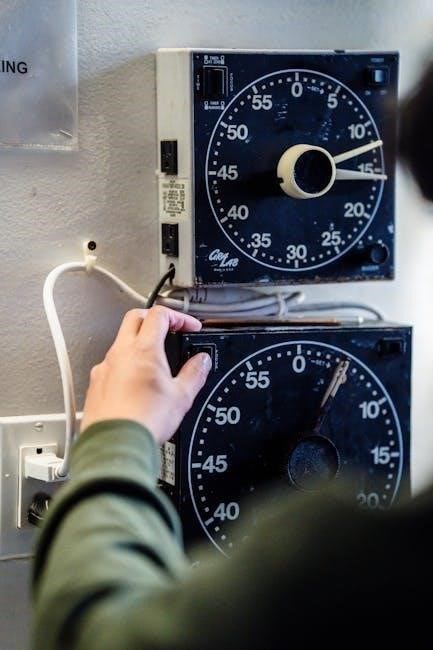
-
By:
- ida
- No comment
how to regenerate water softener manually
Understanding the Need for Manual Regeneration
Manual regeneration ensures your water softener operates efficiently by removing mineral buildup and restoring resin functionality․ It’s essential when automatic cycles fail or salt levels are low․


Identifying Signs for Manual Regeneration
Several indicators signal the need for manual regeneration of your water softener․ If the system fails to regenerate automatically, or if you notice a decline in water quality, such as the return of hard water symptoms, it’s time to act․ Low salt levels in the brine tank or visible mineral buildup on the resin are additional signs․ Some systems may display error messages or flashing lights when regeneration is required․ Water pressure dropping or a salty taste in water also indicates the need for manual intervention․ Regularly checking these signs ensures optimal performance and prevents potential damage to the system․ Ignoring these indicators can lead to inefficiency or even system failure, making timely manual regeneration crucial․

Preparing for Manual Regeneration
Preparing for manual regeneration involves initiating the cycle via the control panel, starting the system’s cleaning process to restore water softening efficiency and function․
Checking Salt Levels
Before manual regeneration, check the salt levels in the brine tank to ensure there is enough salt for the process․ Low salt levels can lead to ineffective regeneration․ Open the brine tank and visually inspect the salt level․ The salt should cover the water surface but not overflow․ If the salt level is low, add pure, non-iodized salt as recommended by the manufacturer․ Avoid using iodized or additives-containing salt, as they can damage the system․ Ensure the salt is evenly distributed and the tank is not overfilled․ Proper salt levels are crucial for the brine solution strength, which determines the effectiveness of the regeneration process․ Regular checks help maintain optimal system performance and water quality․ This step is vital for ensuring the softener functions correctly after manual regeneration․
Adding Salt and Water
Add the recommended amount of pure, non-iodized salt to the brine tank, ensuring it covers the water surface without overflowing․ If the tank is empty, add water to the recommended level before introducing salt․ Always use salt specifically designed for water softeners to avoid contamination․ Once the salt is added, stir gently to dissolve it․ Make sure the lid is securely closed to prevent contamination․ After adding salt and water, allow a few minutes for the solution to mix properly․ This step ensures the brine solution is strong enough to regenerate the resin effectively, which is crucial for softening water․ Proper salt and water levels are essential for maintaining the system’s efficiency and ensuring clean, softened water output․ This process should be done carefully to avoid any system issues․
Using the Control Panel
Locate the control panel on your water softener and press the Regen or Regenerate button․ Hold the button for a few seconds until the display indicates the regeneration cycle has started․ Some systems may require pressing the button once and confirming with a message like Regen Today․ Once initiated, the system will automatically guide the regeneration process․ Ensure the display shows the cycle progress to confirm it’s active․ The regeneration process typically takes about an hour and a half to complete․ Always refer to your specific system’s control panel instructions for exact steps, as variations may exist between models․ Proper use of the control panel ensures a successful manual regeneration cycle․ This step is crucial for restoring your water softener’s effectiveness and ensuring soft water output․
Duration and Monitoring
A manual regeneration cycle typically lasts about an hour and a half, during which the system flushes the resin with a brine solution to remove minerals․ Monitor the control panel to track the cycle’s progress․ Ensure the cycle completes fully to avoid incomplete regeneration, which can reduce efficiency․ Some systems may take longer depending on size and settings․ Listen for sounds indicating cycle stages, such as water flow or draining․ Once done, the system should return to normal operation․ Proper monitoring ensures the process is successful and your water remains soft․ Always allow the full cycle to complete to maintain optimal performance․ Regular checks during regeneration help identify any issues early․

Ensuring Proper Drainage
Proper drainage is crucial during manual regeneration to flush out the brine solution and mineral residue efficiently, ensuring the system operates smoothly and effectively․
Directing Wastewater
During manual regeneration, wastewater containing the brine solution and mineral residue must be properly directed to a drain or designated area․ Proper drainage ensures the system functions efficiently and prevents contamination․ Always direct the wastewater away from plants or surfaces to avoid damage․ Use the provided drain hose to channel the solution into a sink, bucket, or drainage point․ Ensure the drain hose is securely connected to prevent leaks or spills․ After the regeneration cycle, allow the system to complete the flush cycle to remove all residual brine․ Properly dispose of the wastewater to maintain hygiene and environmental safety․ Refer to the manufacturer’s guidelines for specific drainage recommendations․
- Connect the drain hose securely to avoid leaks․
- Direct wastewater to a suitable drainage point․
- Allow the system to complete the flush cycle․

Post-Regeneration Steps
After regeneration, rinse the system thoroughly to remove residual brine and check for proper function․ Clean any spills to ensure optimal performance and hygiene․
Rinsing the System
Rinsing the system after regeneration removes excess brine and ensures clean water flow․ Open the drainage valve to flush the mineral tank thoroughly․ Continue rinsing until the water runs clear, typically requiring multiple cycles․ This step is crucial to prevent any residual salt from entering your water supply․ Ensure all connections are secure to avoid leaks during the process․ Regular rinsing maintains system efficiency and prevents contamination․ Always refer to your manufacturer’s guidelines for specific rinsing procedures tailored to your model․ Proper rinsing ensures the water softener operates effectively and provides softened water consistently․
Checking System Performance
After manual regeneration, it’s essential to verify the system’s performance․ Test the water hardness to ensure it’s within acceptable levels․ Check for any leaks in connections or tanks․ Monitor the flow rate and pressure to confirm they’re consistent with pre-regeneration levels․ Verify that the resin bed is functioning correctly by observing the water quality․ If the water still feels hard or has mineral deposits, the regeneration process may need to be repeated․ Regular performance checks help maintain optimal water softening and prevent future issues․ Always refer to your owner’s manual for specific guidance on evaluating your system’s effectiveness after manual regeneration․

Maintenance and Cost Considerations
Regular maintenance ensures optimal performance and extends system life․ Monitor salt consumption and plan for replacement costs to avoid unexpected expenses․
Monitoring Salt Usage
Regularly checking salt levels in the brine tank is crucial to ensure effective regeneration․ Low salt levels can lead to incomplete mineral removal, reducing water softening efficiency․ It’s recommended to refill salt when levels drop below the recommended threshold, typically when the tank is about one-quarter full․ The type of salt used also matters; pure, non-iodized salt is ideal for maintaining resin health․ Overfilling should be avoided to prevent salt bridges and ensure proper dissolution during the regeneration process․ Consistent monitoring helps maintain system performance and prevents unnecessary repair costs․ Always follow the manufacturer’s guidelines for salt usage to optimize your water softener’s functionality․
Consulting Manufacturer Guidelines

Referencing your water softener’s owner’s manual is essential for manual regeneration․ Each model has specific instructions tailored to its design․ Guidelines typically outline the correct button sequences to initiate regeneration, such as pressing and holding the Regen button until a confirmation message appears․ They also provide details on salt dosage, brine tank capacity, and cycle duration․ Following these steps ensures the system operates within its intended parameters, preventing damage and maintaining efficiency․ Manufacturer recommendations may also include tips for troubleshooting common issues and optimizing system performance․ Always prioritize these guidelines to achieve the best results and extend the lifespan of your water softener․